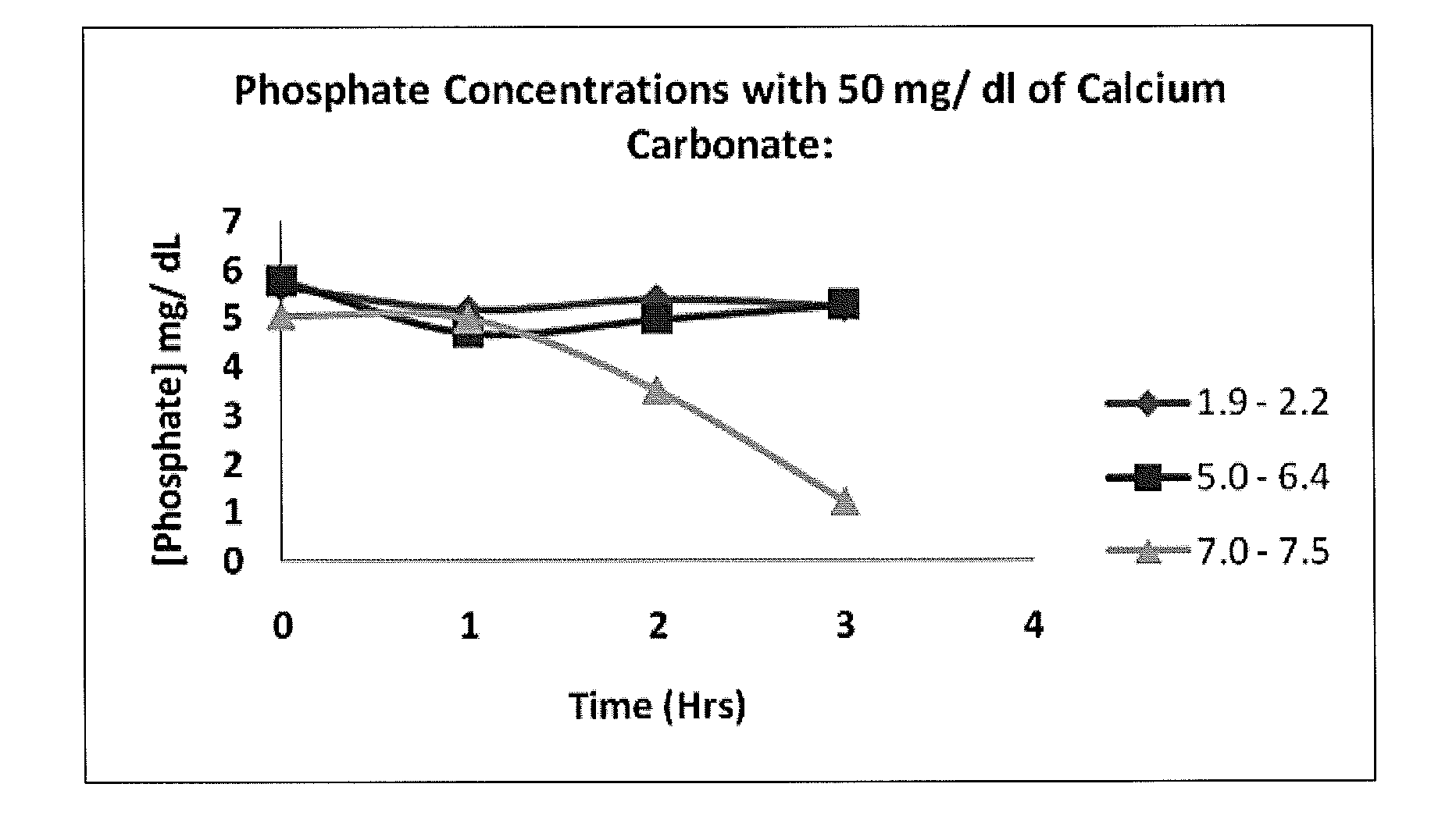Calcium carbonate compositions for preventing or treating hyperphosphatemia
a technology of calcium carbonate and composition, applied in the direction of drug composition, biocide, microcapsule, etc., can solve the problems of renal osteodystrophy, increased dose, and inefficiency of commonly used phosphorus binders, so as to prevent or treat hyperphosphatemia, inhibit the absorption of phosphate in the gastrointestinal tra
- Summary
- Abstract
- Description
- Claims
- Application Information
AI Technical Summary
Benefits of technology
Problems solved by technology
Method used
Image
Examples
example 1
Comparison of Mono- and Dibasic Potassium Phosphate
[0017]Monobasic potassium phosphate (KH2PO4) was used in all in vitro studies as a source of phosphate ions. This was compared to dibasic potassium phosphate (K2HPO4) to determine whether binding of phosphate by CaCO3 was affected by the choice of phosphate source. Tribasic potassium phosphate was not considered as it dissociates in three steps at pka1 of 2.12, pKa2 of 7.21, and pKa3 of 12.67, wherein only the first two steps need to be considered under physiological conditions
[0018]Six 100 ml DI water systems containing 5 mg / dl of phosphate were prepared. Analytical grade KH2PO4 was used as a phosphate source for a set of three systems, and analytical grade K2HPO4 for a set of the remaining three systems (Sigma Chemical Co., St. Louis, Mo.). Then, 100 mg of CaCO3 was added to all systems and pH was adjusted to 3.0, 7.0, and 8.0 for each set, using HCl. All systems were incubated in a shaker at 37° C. and 190 revolutions per minute ...
example 2
Effect of pH on Phosphate Binding
[0021]This in vitro investigation was performed to demonstrate the effect of pH on the phosphate binding capacity of calcium, using calcium carbonate as the phosphate binder and monobasic potassium phosphate as the phosphate source.
[0022]Six 100 ml DI water systems containing 5 mg / dl of phosphate were prepared. Analytical grade KH2PO4 was used as a phosphate source (Sigma Chemical Co., St. Louis, Mo.). Then, 50 mg of CaCO3 was added to a set of three systems and 100 mg of CaCO3 to a set of the remaining three systems. For each set, pH was adjusted to 3.0, 5.0, and 7.0 using HCl. All systems were incubated in a shaker at 37° C. and 190 revolutions per minute (rpm) for 3 hours. Hourly, 1 ml samples were taken from each system and centrifuged in a microcentrifuge for three minutes. Each sample was then diluted 100× for measurement within the detectable range required by BIOASSAY Systems. In addition, pH was also measured hourly using a handheld waterpro...
example 3
In Vitro Comparison of Phosphate Binders
[0025]A series of in vitro experiments were performed to compare the efficacy of commonly used phosphate binders at different pH levels. The major phosphate binders currently on the market are calcium acetate (PhosLo®), lanthanum carbonate (Fosrenol®), sevelamer HCl (Renagel®) and, to a lesser extent, calcium carbonate.
[0026]Four 100 ml DI water systems were prepared in sterile disposable containers, each containing 5 mg / dl of phosphate. One system was for control, while 100 mg of CaCO3 was added to each of the remaining three systems. Then, pH levels were adjusted to 3.0, 7.0 and 8.0. All four systems were incubated in a shaker at 37° C. and 190 rpm for 4 hours. Every 30 minutes, samples were taken and pH was adjusted. Each sample was diluted 100× for measurement using the malachite green phosphate assay kit (BIOASSAY Systems, Hayward, Calif.). All samples were measured for absorbance at the 650 nm wavelength using a JASCO spectrophotometer V...
PUM
 Login to View More
Login to View More Abstract
Description
Claims
Application Information
 Login to View More
Login to View More - R&D
- Intellectual Property
- Life Sciences
- Materials
- Tech Scout
- Unparalleled Data Quality
- Higher Quality Content
- 60% Fewer Hallucinations
Browse by: Latest US Patents, China's latest patents, Technical Efficacy Thesaurus, Application Domain, Technology Topic, Popular Technical Reports.
© 2025 PatSnap. All rights reserved.Legal|Privacy policy|Modern Slavery Act Transparency Statement|Sitemap|About US| Contact US: help@patsnap.com


